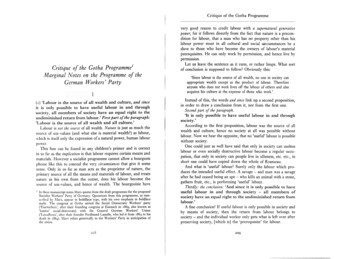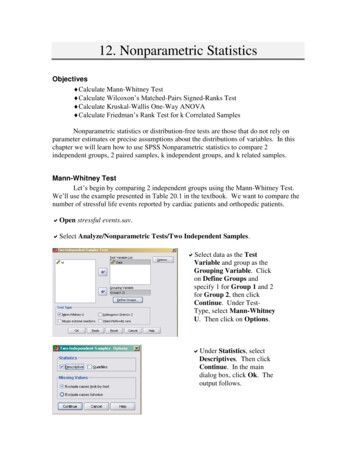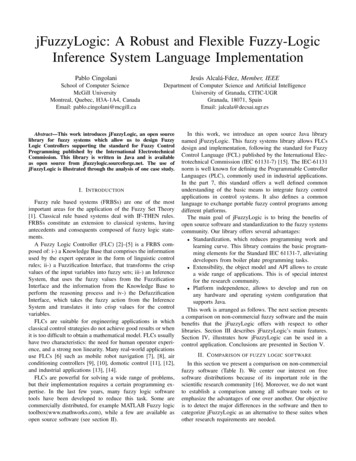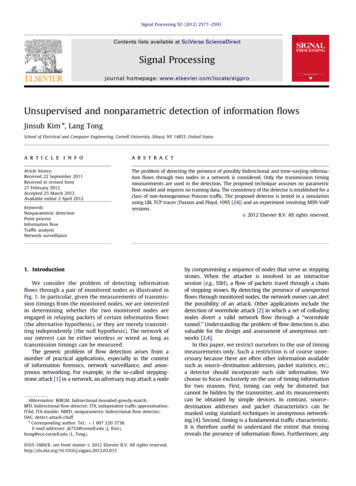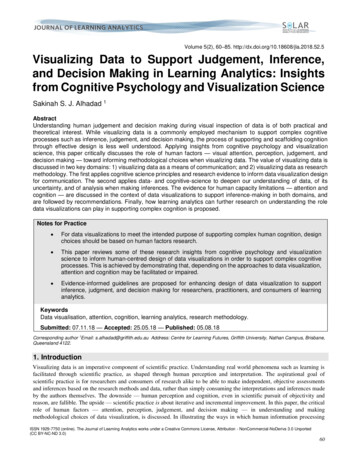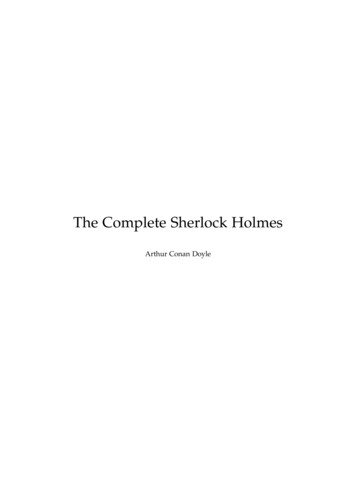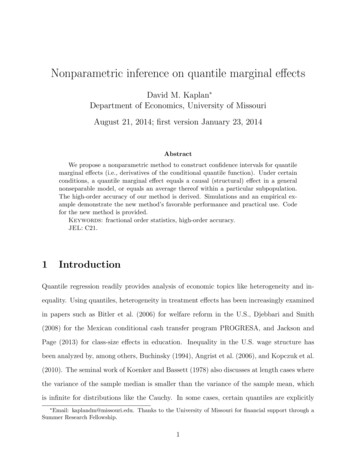
Transcription
Nonparametric inference on quantile marginal effectsDavid M. Kaplan Department of Economics, University of MissouriAugust 21, 2014; first version January 23, 2014AbstractWe propose a nonparametric method to construct confidence intervals for quantilemarginal effects (i.e., derivatives of the conditional quantile function). Under certainconditions, a quantile marginal effect equals a causal (structural) effect in a generalnonseparable model, or equals an average thereof within a particular subpopulation.The high-order accuracy of our method is derived. Simulations and an empirical example demonstrate the new method’s favorable performance and practical use. Codefor the new method is provided.Keywords: fractional order statistics, high-order accuracy.JEL: C21.1IntroductionQuantile regression readily provides analysis of economic topics like heterogeneity and inequality. Using quantiles, heterogeneity in treatment effects has been increasingly examinedin papers such as Bitler et al. (2006) for welfare reform in the U.S., Djebbari and Smith(2008) for the Mexican conditional cash transfer program PROGRESA, and Jackson andPage (2013) for class-size effects in education. Inequality in the U.S. wage structure hasbeen analyzed by, among others, Buchinsky (1994), Angrist et al. (2006), and Kopczuk et al.(2010). The seminal work of Koenker and Bassett (1978) also discusses at length cases wherethe variance of the sample median is smaller than the variance of the sample mean, whichis infinite for distributions like the Cauchy. In some cases, certain quantiles are explicitly Email: kaplandm@missouri.edu. Thanks to the University of Missouri for financial support through aSummer Research Fellowship.1
of interest, such as with low birthweight (for example Abrevaya, 2001; Chernozhukov andFernández-Val, 2011) or value-at-risk (for example Chernozhukov and Umantsev, 2001).Nonparametric quantile regression provides additional robustness by obviating the functional form assumption and provides additional heterogeneity by allowing the regressionfunction’s slope to vary arbitrarily with the regressors (as well as quantile). The slope alsorelates to causal effects in nonseparable models. Hoderlein and Mammen (2007), and Sasaki(2012), among others, relate the derivative of the conditional quantile function (a.k.a. thequantile marginal effect) to derivatives of a nonseparable structural function. Under certainconditions, this object is equal to a causal (structural) effect or an average of causal effectsamong a specific subpopulation. See §2 below for more mathematical details.This paper concerns inference on the quantile marginal effect. In related work, Kaplan(2011), Goldman and Kaplan (2014a), and Goldman and Kaplan (2014b, hereafter GK)discuss high-order accurate nonparametric inference on unconditional and conditional quantiles, as well as inference on multiple quantiles jointly, on linear combinations of quantiles(e.g. interquantile ranges), and on quantile treatment effects for a binary treatment variable.If a treatment variable is discrete (but not binary) and the marginal effect going from, e.g.,T 2 to T 3 is of interest, then their existing framework is sufficient: a new binaryvariable W 1{T 3} is the “treatment,” and only observations with T 2 or T 3 areused, where 1{·} is the indicator function. Here, we propose a new method for inference onthe quantile marginal effect with respect to a continuous variable.Our new method relies on the fact that a function’s derivative may be approximated by alinear combination of function values near the point of interest. This is the same idea behindcomputing numerical derivatives. As described in Definition 3, this approximation and localsmoothing reduce the problem to inference on an unconditional quantile treatment effect.There are three sources of coverage probability error: the derivative approximation, thesmoothing of continuous variable(s), and the application of the unconditional method. Theseare all precisely characterized, and then the optimal bandwidth and coverage properties are2
derived. The key assumption is on sampling (A1); mild smoothness assumptions are alsorequired.The primary contribution of this paper is the new method for constructing QME confidence intervals and the characterization of its properties. The approach differs greatly frombootstrap or normality-based confidence intervals based on local polynomials. This includesa new feasible (plug-in) bandwidth that targets coverage probability accuracy rather thanestimation precision. As in many cases, the bandwidth minimizing the mean squared errorof a local polynomial estimator does not lead to even first-order accurate inference becausesuch a bandwidth equates the estimator’s bias with its standard deviation (in order of magnitude). The truly optimal bandwidth arguably lies in between since there is (within thisrange) a tradeoff between coverage accuracy and confidence interval length, though “optimal” depends on one’s objective function. In practice, we suggest (and implement in ourcode) shifting toward the larger bandwidth rate as the sample size grows.The new method has advantages over the local polynomial approaches. Under the assumptions in this paper, the new method’s optimal coverage probability error is smallerthan a local polynomial’s, O(n 12/25 ) versus O(n 3/8 ), although by assuming smoothnessapproaching infinity and fitting a polynomial of degree approaching infinity the latter theoretically approaches O(n 1/2 ). Practically, this means the advantage of the local polynomialis in the case where there is sufficient data to fit higher-degree local polynomials and wherethe underlying function is volatile enough to restrict the new method’s bandwidth. In simulations, performance is quite similar in many cases, both with local linear and cubic estimators. However, the analytic normality-based intervals (from Chaudhuri, 1991) can havesevere under-coverage or over-coverage. The bootstrapped local polynomial intervals onlysuffer significant under-coverage in more extreme cases, but they have the usual bootstrapdrawbacks of relying on randomization and taking longer to compute. Bootstrap intervalscan be longer in some cases, too.Sections 2 and 3 detail our setup, procedure, and theoretical results. Section 4 contains3
.a simulation study, and Section 5 contains an empirical application. Notationally, shouldbe read as “is equal to, up to smaller-order terms”; as “has exact (asymptotic) rate/orderof” (same as “big theta” Bachmann–Landau notation, Θ(·)); and An O(Bn ) as usual, k s.t. An Bn k for sufficiently large n. Acronyms used are those for cumulativedistribution function (CDF), confidence interval (CI), coverage probability (CP), coverageprobability error (CPE), mean squared error (MSE), probability density function (PDF),quantile marginal effect (QME), and quantile treatment effect (QTE). Vectors are columnvectors unless otherwise noted, and 0 denotes transpose. Proofs absent in the main text arein the appendix. Code is available from the author’s website.2SetupWe adopt the definitions of “structural marginal effect” and “quantile marginal effect”(QME) from Sasaki (2012). He defines a nonparametric, nonseparable structural (causal)function Y g(X, U ), where Y is the scalar outcome of interest, X is the regressor(taken to be a scalar for simplicity), and U RM is a vector of unobserved determinantsof Y . The non-structural conditional τ -quantile function of Y given X x is denoted QY X (τ x) inf y : FY X (y x) τ , where Y and X are as before and τ (0, 1) is thequantile of interest, such at τ 0.5 for the median. The following are respectively Definitions1 and 2 in Sasaki (2012), with only slight notational differences.Definition 1 (structural marginal effect). Given a structural function g(·, ·), the structuralmarginal effect at (X x0 , U u0 ) is given by β(x0 , u0 ) g(x, u0 ) x x0 . xDefinition 2 (quantile marginal effect). Given a quantile regression QY X (· ·), the quantilemarginal effect (QME) at X x0 is defined by Q (τ x Y X x)x x0for each quantile τ (0, 1).The QME equals the structural marginal effect if X is exogenous, U is scalar, and g(·, ·)is monotone in U . They are also equal (Sasaki, 2012, Cor. 1) if monotonicity is weakened to4
“local monotonicity,” where the value u s.t. y g(x0 , u ) is unique.Under much weaker conditions, Sasaki (2012) shows, “the quantile marginal effect identifies a weighted average of structural marginal effects among the subpopulation of individualsat the conditional quantile of interest.” For example, if τ 0.9, x0 0, and QY X (τ 0.9 X 0) 1.3, then the average is taken over different values of U {u : g(x 0, u) 1.3}.If U (U1 , U2 ) and g(X, U ) X U1 U2 , then in this example the average is over{u : u1 u2 1.3}. Sasaki (2012, Cor. 2) states that when 2g(x, u)ui uj 0 for i 6 j, theweights in the average are proportional to the PDF of U .Let outcome Y R and regressor of interest X R both have continuous distributions.Let W be a vector of other control variables. The population object of interest is the QMEat X x0 and W w0 for quantile of interest τ (0, 1): QY X,W (τ x, w0 ) x.(1)x x0If W contains a fixed number of discrete variables with P (W w0 ) p 0, then themethod can be run on the subset of observations with W w0 . Since this approach does notaffect the asymptotic properties,1 discrete W are omitted hereafter for notational simplicity.Nonetheless, it is possible in finite samples to have no observations with W w0 . Whileformal analysis of such cases is beyond the present paper’s scope, the choice then is eitherto decide the data contain negligible information about W w0 or to assume that valuesclose to w0 are similar enough to yield reasonable inferences about w0 , which depends on theeconomic meaning of W and how similar nearby values are.If W contains continuous variables, then P (W w0 ) 0 and smoothing is required. Asshown in Goldman and Kaplan (2014a), this will not increase the order of the bias beyondthat caused by X being continuous, but it will decrease the growth rate of the local samplesize and thus affect the theoretical coverage.1The probability that the number of observations with W w0 is outside a given range of fixed proportions of the overall sample size n, i.e. outside [npc1 , npc2 ] for 0 c1 1 c2 , asymptotically decays to zeroat an exponential rate, which by the Borel–Cantelli Lemma implies it occurs only finitely often; so the localsample size with W w0 is asymptotically the same order of magnitude as the overall sample size n.5
Our new method is based on the derivative approximation f 0 (x) [f (x h) f (x h)]/(2h). The controls W are temporarily ignored. For some bandwidth h 0, onlyobservations within the windows [x0 , x0 2h] and [x0 2h, x0 ) are considered. A confidenceinterval (CI) for the difference between the two windows’ τ -quantiles can be computed. Inprinciple, any method for quantile treatment effect (QTE) inference would suffice; we useGK and Kaplan (2011) for their high-order accuracy and fast computation. Up to bias, theQTE is approximately QY X (τ x0 h) QY X (τ x0 h), so dividing by 2h yields anapproximation of the QME. Definition 3 enumerates these steps.Definition 3 (QME inference method). The steps to compute our method are:(i) Choose a desired coverage probability (CP) 1 α, quantile of interest τ (0, 1), andpoint of interest (x0 , w00 )0 .(ii) Normalize each continuously distributed element of Wi to have the same sample variance as Xi (since a common bandwidth is used).(iii) Select a bandwidth h 0 possessing the optimal rate from Theorem 4, such as theplug-in bandwidth suggested immediately after Theorem 4.(iv) Define the “lower local sample” to be observed values of Yi for which (Xi , Wi0 )0 Ch :Xi [x0 2h, x0 ), continuously distributed elements of Wi are within the correspondingelements of [w0 h, w0 h], and discretely distributed elements of Wi are equal to thecorresponding elements of w0 . Define the “upper local sample” to be almost the same,but instead for Xi [x0 , x0 2h].(v) Construct a CI for the QME at the point of interest: first, apply the QTE inference ofGK or Kaplan (2011) with the upper local sample as the “treatment” sample and thelower local sample as the “control” sample; second, divide the endpoint values by 2h.The key remaining steps are to characterize the order of magnitude of each source ofcoverage probability error (CPE) and then solve for the optimal bandwidth rate. This in6
turn determines the overall CPE.We maintain the following assumptions and definitions.Assumption A1. For continuous scalars Yi and Xi , and vector of controls Wi whose firstd 1 elements are continuously distributed and whose fixed number of remaining elementsare discretely distributed with finite support: vector (Yi , Xi , Wi0 )0 is sampled iid from itspopulation distribution for i 1, . . . , n. The point of interest x0 lies in the interior of thesupport of X, and similarly for the d 1 continuous elements of w0 and their correspondingsupports.Assumption A2. The joint density of X and W , fX,W (·, ·), satisfies fX,W (x0 , w0 ) 0 andhas a Lipschitz continuous partial derivative in each of the d dimensions in a neighborhood of(x0 , w00 )0 .For example, for constant c 0 and small enough h to be within the neighborhood, f(x0 x X,W h, w0 ) f(x0 , w0 ) x X,W c h .Assumption A3. For all u in a neighborhood of τ and all w̃ in a neighborhood of w0(or simply w̃ w0 if d 1 0), QY X,W (u x, w̃) has at least two Lipschitz continuousderivatives in x.Assumption A4. For the bandwidth h, as n , (i) h 0, (ii) nhd /[log(n)]2 .Assumption A5. The conditional density of Y given X and W is positive at the point of interest: fY X,W QY X,W (τ x0 , w0 ) x0 , w0 0.Assumption A6. For all y in a neighborhood of QY X,W (τ x0 , w0 ), all x in a neighborhoodof x0 , and all w in a neighborhood of w0 (with the discrete elements simply the same as w0 ),fY X,W (y x, w) has at least two Lipschitz continuous derivatives in its first argument (y).Assumption A1 is stronger than necessary for first-order accuracy; see Fan and Liu (2012).Assumptions A5, A6, and A4(ii) satisfy the requirements of GK and Kaplan (2011). Assumptions A2, A3, and A4(i) control the bias. Assumptions A2, A3, and A6 are equivalentto sx 2, sQ 3, and sY 3 in the notation of Goldman and Kaplan (2014a).7
Definition 4 (local sample). The local samples are the Yi values whose Xi and Wi arewithin one of the two windows defined by the bandwidth h. When W contains only discretevariables, the two windows and local sample sizes areCh {(x, w00 )0 : x [x0 , x0 2h]},Ch {(x, w00 )0 : x [x0 2h, x0 )},(2)Nn #({Yi : (Xi , Wi0 )0 Ch }),Nn #({Yi : (Xi , Wi0 )0 Ch }).(3)Additionally, the τ -quantile of Y conditional on (X, W 0 )0 Ch or Ch isQY Ch (τ ) inf{y : τ P (Y y (X, W 0 )0 Ch )},(4)QY Ch (τ ) inf{y : τ P (Y y (X, W 0 )0 Ch )}.(5)There are two effects of using the local samples: first, the number of observations used,Nn Nn , is of smaller order than the overall sample size n; second, there is bias fromincluding observations with Xi 6 x0 . The first effect causes accuracy to increase with h,while the second effect causes accuracy to decrease with h. This tension helps determine theoptimal bandwidth. The common order of magnitude of Nn and Nn (ensured by A1, A2,and A4) will be denoted Nn .3Theoretical resultsThe object of interest is the QME defined in (1). We approximateQY Ch (τ ) QY Ch (τ )2h QME(τ, x0 , w0 ) ApproxErr Biash Biash ,2h(6)Biash QY Ch (τ ) QY X,W (τ x0 h, w0 ),(7)Biash QY Ch (τ ) QY X,W (τ x0 h, w0 ),(8)ApproxErr QY X,W (τ x0 h, w0 ) QY X,W (τ x0 h, w0 ) QME(τ, x0 , w0 ).2h8(9)
Lemma 1 characterizes the orders of magnitude of the two error terms in (6).Lemma 1. Under Assumptions A1–A6, Definition 4, and the QME definition in (1),QY Ch (τ ) QY Ch (τ ) QME(τ, x0 , w0 ) O(h2 ).2h(10)The goal of our method is accurate coverage probability (CP). Specifically, let coverageprobability error (CPE) be c (1 α),CPE P QME(τ, x0 , w0 ) CI(11)where 1 α is the nominal CP (e.g., 0.95) and the hat over CI is a reminder that the CIendpoints are random variables. In this section, we characterize the CPE order of magnitudefor our new method, starting with the CPE due to bias.Lemma 2 (CPE from bias). Under Assumptions A1–A6 and Definition 4, for the method in Definition 3, the CPE due to the bias in Lemma 1 is CPEBias O(h3 Nn ).In addition to CPEBias , CPEQTE denotes the CPE from invoking the unconditional QTEinference method. While there is no “treatment” per se, the numerator of the left-hand sideof (10) is equivalent to a τ -QTE: it is the difference in τ -quantile between (sub)populationsCh and Ch , from which we have independent draws of Y .The rate-limiting source of CPE for both unconditional QTE methods is PDF estimation 2/3error in the two-sided case, so contribute O(Nn) CPE. In Kaplan (2011), the PDF esti-mates enter the standard error directly. In GK, they enter only through nuisance parameterγ, the ratio of “treatment” and “control” PDFs evaluated at the quantile of interest. 1/2If γ is known, then the GK CPE is O(Nn 1 ). (For one-sided CIs, it is O(Nnway, for either method.) Here, γ 1 O(h):fY X (QY X (τ x0 h) x0 h) fY X (QY X (τ x0 h) x0 ) O(h) fY X (QY X (τ x0 ) x0 ) O(h),9) either
using the smoothness in (and implied by) A3 and A6. The same holds at x0 h, so the ratiois 1 O(h). The CPE in GK from estimation of γ is the same order of magnitude as thebias of γ̂ plus its variance. If the “estimator” γ̂ 1 is used, then the bias is O(h) and thevariance is zero, so CPE is O(h Nn 1 ).Lemma 3. Under Assumptions A1–A6 and Definition 4, the CPE of the two-sided CI forQY Ch (τ ) QY Ch (τ )2h 2/3 2/3is CPEQTE O min{h Nn 1 , Nn } using GK or O(Nn ) using Kaplan (2011). Both 1/2methods have one-sided CPEQTE O Nn. 1/2For one-sided CIs, the optimal h balances h3 Nn and Nn , which yields h n 1/(3 d)and overall CPE O(n 3/(6 2d) ). For two-sided CIs, due to the different possible γ̂, there aretwo local minima of CPE as a function of h. The results are summarized in Table 1.Table 1: Effect of h on CPE for two-sided QME CIs, under Assumptions A1–A6.h(n 1/d , n 1/(1 d) )n 1/(1 d)(n 1/(1 d) , n 2/(3 2d) ](n 2/(3 2d) , n 7/(18 7d) )n 7/(18 7d) 7/(18 7d)(n, n 1/(3 d) )[n 1/(3 d) , n 1/(6 d) )n 1/(6 d)DominantCPE termNn 1Nn 1 , hh 2/3Nn 2/3Nn , h3 Nnh3 Nnh3 Nnh3 NnCPEo(1) 1/(1 d)O(n)O(h) 2/3O(Nn )O(n 12/(18 7d)) O(h3 Nn )O(h3 Nn )O(1)NotesO(1) CPE with h n 1/dlocal CPE minlocal CPE minsame CPE as normalityMSE-optimal hTheorem 4 (optimal bandwidth and CPE). For the method in Definition 3 constructinga two-sided CI for the QME defined in (1), under Assumptions A1–A6, the CPE-optimalbandwidth rate is h n 7/(18 7d) , and corresponding CPE is O(n 12/(18 7d) ). With d 1and GK, using γ̂ 1 and bandwidth h n 1/2 slightly improves CPE, to O(n 1/2 ) fromO(n 12/25 ). For one-sided CIs, the CPE-optimal bandwidth rate is h n 1/(3 d) , resultingin O(n 3/(6 2d) ) CPE.10
For a plug-in bandwidth, we suggest taking the plug-in bandwidth from Goldman andKaplan (2014a) for two-sided inference on QY X,W (τ x0 , w0 ), which is proportional ton 1/(2 d) , and multiplying by n4/[(18 7d)(2 d)] to match the two-sided rate in Theorem 4. Sincethe overall window width is 4h here, as opposed to 2h in Goldman and Kaplan (2014a), wealso divide by two. For one-sided intervals, multiplying instead by n1/[(2 d)(3 d)] gives thecorrect rate. There is still room for improvement since, for example,
This paper concerns inference on the quantile marginal e ect. In related work, Kaplan (2011), Goldman and Kaplan (2014a), and Goldman and Kaplan (2014b, hereafter GK) discuss high-order accurate nonparametric inference on unconditional and conditional quan-tiles, as well as inference on
